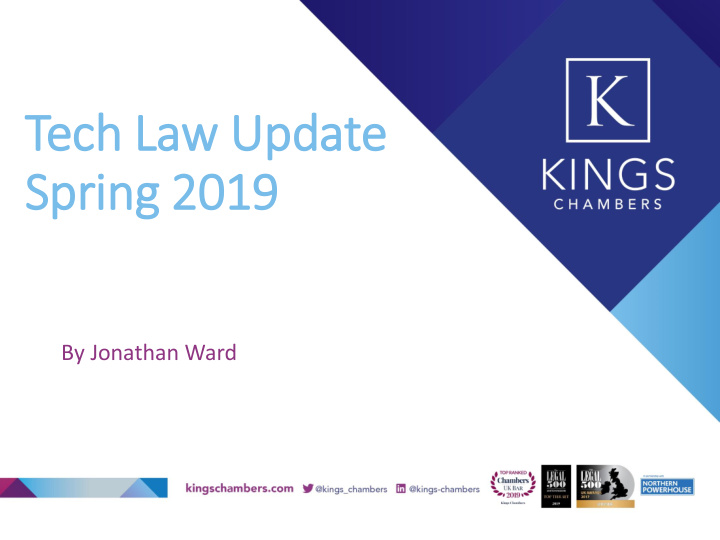



Tech Law Update Spring 2019 By Jonathan Ward
In Intro to IT IT Proje ject Disputes • The typical scenarios • Goods, services, or something else? • The importance of categorisation • Methodology, duties and cooperation • Standard of care • Remedies
Is Is Software Goods? • What is software? • St. Albans v ICL [1997] F.S.R. 251 • “ If the disc is sold or hired by the computer manufacturer, but the program is defective… there would prima facie be a breach of the terms as to quality and fitness for purpose implied by the Sale of Goods Act …”
Is Is Software Goods? • Computer Associates UK Ltd v Software Incubator Ltd [2018] EWCA Civ 518 • Under the Commercial Agents Regulations • Analogy with databases • Software is not “goods” under the Regulations • Appeal outstanding – 28 March 2019
Is Is Software Goods? • Is the St. Albans approach sustainable? • The US courts take a different approach: software is typically considered as goods under the Uniform Commercial Code. • Different considerations if the software is merely licensed: Eurodynamic Systems v General Automation Ltd / Mayor and Burgesses of Southwark LBC v IBM UK Ltd
Is Is Software Goods? • Contrast with the situation where software runs on a product also supplied under the contract
Or Services? • E.g. contracts for consultancy. • What if the contract is ongoing and no “product” has been delivered? • Salvage Assoc v CAP [1995] F.S.R. 654
Or Something Else? • Consumer Rights Act 2015 • s2: “‘Goods’ means any tangible moveable items… ‘ Digital content’ means data which are produced and supplied in digital form.” • s.16: “goods” may include digital content. • s.34-36: digital content to be of satisfactory quality, fit for its intended purpose, and as described.
Typical Obligations • An obligation to provide a system which is of satisfactory quality and reasonably fit for its intended purpose is generally recognised: ICL; Saphena Computing v ACA [1995] F.S.R. 616
Limitations and Qualifications • When do the satisfactory quality / fitness for intended purpose obligations arise? • “No claim is made in relation to late delivery of any of the software, and there can be no breach of the implied term until the software is delivered.” - Saphena
Limitations and Qualifications • How far do the obligations go? • “…it is important to remember that software is not necessarily a commodity which is handed over or delivered once and for all at one time… It would not be a breach of contract at all to deliver software in the first instance with a defect in it.” ( Saphena)
Defects and Testing • A “duty and a right” to test and modify, in a reasonable time. • Would the Saphena reasoning still apply? • What was the expert actually saying? • Distinguish between “business logic” defects and other “bugs”. • Some defects may simply be evidence that the requirements have not been communicated.
Agile Development Waterfall is a sequential methodology of software development. Broadly speaking, the starting point is generally contract requirements specified at a relatively high level from which more detailed functional and technical specifications are produced. Relevant coding and documentation are then derived using those specifications. Each module of software is then tested by itself and in conjunction with the other modules till the whole system is complete and working. By contrast, with Agile development the supplier undertakes a series of very short software developments ("sprints") based on iterative incremental development which eventually build up to the complete system. Requirements and solutions evolve through collaboration between self-organising cross-functional teams. Significant customer input is usually necessary during the sprints, and customer testing of the module during or at the end of each sprint is common. ( David Macbrayne v Atos IT Services [2018] CSOH 32 )
The Im Importance of f the Specification • Functional specification gives meaning to the quality obligations. • “minimum viable product”. • Consider the tolerance of critical, major and minor bugs in the specification, and against the timeline. • Note terms such as “commercial release”, “beta” etc.
Case Update: B2C2 Ltd v Quoine • [2019] SGHC(I) 03 • Claim against crypto-currency trading platform • B2C2 sold ETH at 250x the going rate due to software defect on platform • Quoine reversed the transaction • B2C2 claimed breach of contract • Proprietary claim for BTC taken from account
B2C2 Ltd v Quoine: : Sig ignificant Poin ints • Is BTC property? • Should term be implied to enable reversal of trades? • Unilateral mistake: whose mistake is relevant when the trades are algorithmic on both sides?
Case Update: : Trip iple Poin int Technology v PTT Public Company • [2019] EWCA Civ 230 • Software project • Supplier suspends work for non-payment • LADs: 0.1% value of undelivered work per day • Contract terminated before completion
Trip iple Poin int Technology v PTT Public Company • Application of liquidated damages clause when project never finished • Jackson LJ identified three lines of authority • Preferred application of British Glanzstoff Manufacturing v General Accident, Fire and Life Assurance (1913 SC (HL) 1 ) • Work unfinished, not late. No LADs payable.
Thank you Follow us on: @kings_chambers kings-chambers
Recommend
More recommend